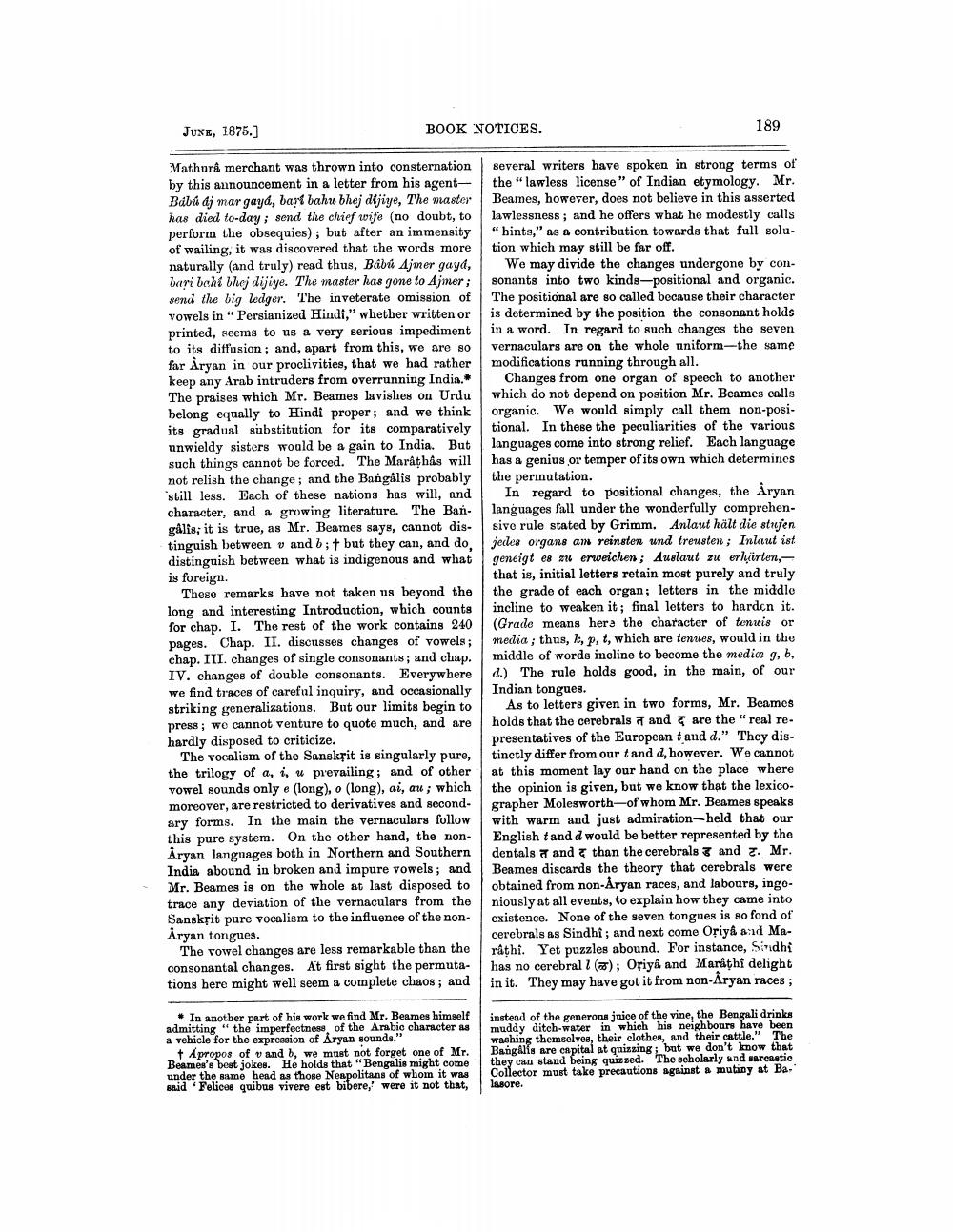________________
JUXE, 1875.)
BOOK NOTICES.
189
Mathura merchant was thrown into consternation several writers have spoken in strong terms of by this announcement in a letter from his agent- the "lawless license " of Indian etymology. Mr. Bali dj mar gaya, bart bahu bhej dijiye, The master Beames, however, does not believe in this asserted has died to-day; send the chief wife (no doubt, to lawlessness; and he offers what he modestly calls perform the obsequies); but after an immensity "hints," as a contribution towards that full soluof wailing, it was discovered that the words more tion which may still be far off. naturally (and truly) read thus, Babi Ajmer gaya, Wo may divide the changes undergone by conbari bchi bhej dijiye. The master has gone to Ajmer; sonants into two kinds-positional and organic. send the big ledger. The inveterate omission of The positional are so called because their character vowels in Persianized Hindi," whether written or is determined by the position the consonant holds printed, seems to us a very serious impediment in a word. In regard to such changes the seven to its diffusion; and, apart from this, we are so vernaculars are on the whole uniform--the same far Aryan in our proclivities, that we had rather modifications running through all. keep any Arab intruders from overrunning India. Changes from one organ of speech to another The praises which Mr. Beames lavishes on Urdu which do not depend on position Mr. Beames calls belong oqually to Hindi proper; and we think organic. We would simply call them non-posi. its gradual substitution for its comparatively tional. In these the peculiarities of the various unwieldy sisters would be a gain to India. But languages come into strong relief. Each language such things cannot be forced. The Marathas will has a genius or temper of its own which determines not relish the change and the Bangalis probably the permutation. 'still less. Each of these nations has will, and In regard to positional changes, the Aryan character, and a growing literature. The Ban- languages fall under the wonderfully comprehengális; it is true, as Mr. Beames says, cannot dis- sivo rule stated by Grimm. Anlaut hält die stufen tinguish between y and b;t but they can, and do joles organs am reinsten und trensten; Inlaut ist distinguish between what is indigenous and what geneigt es 21 erweichen; Auslaut zu erhuirten, is foreign
that is, initial letters retain most purely and truly These remarks have not taken us beyond the the grade of each organ; letters in the middlo long and interesting Introduction, which counts incline to weaken it; final letters to harden it. for chap. I. The rest of the work contains 240 (Grade means hera the character of tenuis or pages. Chap. II. discusses changes of vowels; media ; thus, k, p, t, which are tenues, would in the chap. III. changes of single consonants; and chap. middle of words incline to become the media 9, b, IV. changes of double consonants. Everywhered.) The rule holds good, in the main, of our we find traces of careful inquiry, and occasionally Indian tongues. striking generalizations. But our limits begin to As to letters given in two forms, Mr. Beamos press; we cannot venture to quote much, and are holds that the cerebrals and are the "real rehardly disposed to criticize.
presentatives of the European t and d." They disThe vocalism of the Sanskrit is singularly pure, tinctly differ from our tand d, however. We cannot the trilogy of a, i, * prevailing; and of other at this moment lay our hand on the place where vowel sounds only e (long), o (long), ai, au ; which the opinion is given, but we know that the lexicomoreover, are restricted to derivatives and second- grapher Molesworth of whom Mr. Beames speaks ary forms. In the main the vernaculars follow with warm and just admiration-held that our this pure system. On the other hand, the non- English tand d would be better represented by tho Aryan languages both in Northern and Southern dentals 7 and than the cerebrals 3 and z. Mr. India abound in broken and impure vowels; and Beames discards the theory that cerebrals were Mr. Beames is on the whole at last disposed to obtained from non-Aryan races, and laboure, ingotrace any deviation of the vernaculars from the niously at all events, to explain how they came into Sanskrit pure vocalism to the influence of the non- existence. None of the seven tongues is so fond of Åryan tongues.
cerebrals as Sindhi; and next come Oriya and MaThe vowel changes are less remarkable than the rathi. Yet puzzles abound. For instance, Siridhi consonantal changes. At first sight the permuta- has no cerebral l(); Oriya and Marathi delight tions here might well seem a complete chaos; and in it. They may have got it from non-Aryan races;
• In another part of his work we find Mr. Beames himself admitting "the imperfectness of the Arabic characters a vehicle for the expression of Aryan sounds."
† Apropos of vand b, we must not forget one of Mr. Beames's best jokes. He holds that "Bengalis might come under the same head as those Neapolitans of whom it was said 'Felices quibus vivere est bibere,' were it not that,
instead of the generous juice of the vine, the Bengali drinks muddy ditch-water in which his neighbours have been washing themselves, their clothes, and their cattle." The Bangalls are capital at quinzing . but we don't know that they can stand being quizzed. The scholarly and sarcastic Collector must take precautions against a mutiny at Ba. lasore.




